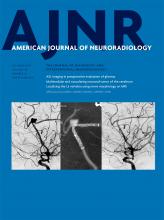Abstract
BACKGROUND AND PURPOSE: Traditional neuroimaging markers of small-vessel disease focus on late-stage changes. We aimed to adapt a method of venular assessment at 7T for use in older adults. We hypothesized that poorer venular morphologic characteristics would be related to other small-vessel disease neuroimaging markers and a higher prevalence of small-vessel disease–Alzheimer disease risk factors.
MATERIALS AND METHODS: Venules were identified in periventricular ROIs on SWI and defined as tortuous or straight. The tortuosity ratio was defined as total tortuous venular length divided by total straight venular length. White matter hyperintensity burden (visually rated from 0 to 3) and the number of microbleeds (0, 1, >1) were determined. Differences in tortuous and straight venular lengths were evaluated. Relationships with demographic variables, allele producing the e4 type of apolipoprotein E (APOE4), growth factors, pulse pressure, physical activity, and Modified Mini-Mental State Examination were assessed via Spearman correlations.
RESULTS: Participants had 42% more tortuous venular tissue than straight (median, 1.42; 95% CI, 1.13–1.62). APOE4 presence was associated with a greater tortuosity ratio (ρ = 0.454, P = .001), and these results were robust to adjustment for confounders and multiple comparisons. Associations of the tortuosity ratio with sex and vascular endothelial growth factor did not survive adjustment. Associations of the tortuosity ratio with other variables of interest were not significant.
CONCLUSIONS: Morphologic measures of venules at 7T could be useful biomarkers of the early stages of small-vessel disease and Alzheimer disease. Longitudinal studies should examine the impact of apolipoprotein E and vascular endothelial growth factor on the risk of venular damage.
ABBREVIATIONS:
- AD
- Alzheimer disease
- APOE4
- allele producing the e4 type of apolipoprotein E
- BDNF
- brain-derived neurotrophic factor
- IQR
- interquartile range
- LIFE MRI
- Lifestyle Interventions and Independence for Elders Magnetic Resonance Imaging study
- 3MS
- Modified Mini-Mental State Examination
- SVD
- small-vessel disease
- VEGF
- vascular endothelial growth factor
- WMH
- white matter hyperintensities
- © 2017 by American Journal of Neuroradiology
Indicates open access to non-subscribers at www.ajnr.org












